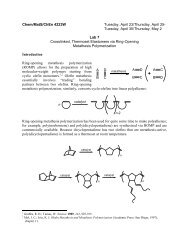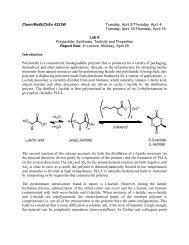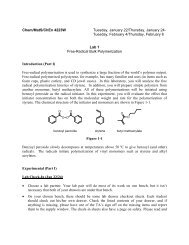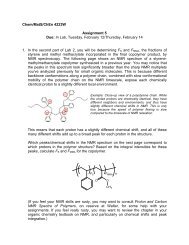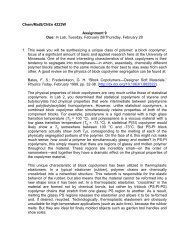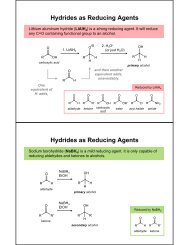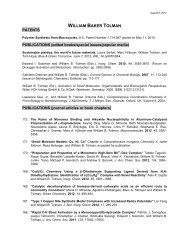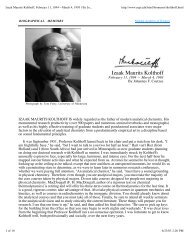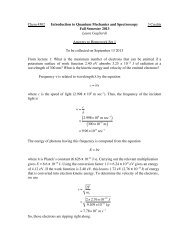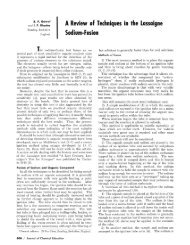An Exercise in Freezing Point Depression
An Exercise in Freezing Point Depression
An Exercise in Freezing Point Depression
- No tags were found...
Create successful ePaper yourself
Turn your PDF publications into a flip-book with our unique Google optimized e-Paper software.
Part III: Determ<strong>in</strong><strong>in</strong>g the Enthalpy of Solution, ∆H solnMany factors go <strong>in</strong>to mak<strong>in</strong>g a deicer both effective and practical. <strong>An</strong> obvious one,perhaps so obvious we usually don’t mention it, is solubility. S<strong>in</strong>ce freez<strong>in</strong>g po<strong>in</strong>tdepression is proportional to the molality of the dissolved solute, a solute with lowsolubility <strong>in</strong> water would be useless as a deicer. Therefore, you wouldn’t expect to seeCaCO 3used as a deicer because of its low solubility although it has other problems aswell.<strong>An</strong>other factor to consider <strong>in</strong> select<strong>in</strong>g a deicer is its enthalpy of solution. If a soliddissolves exothermically, it will provide heat to its surround<strong>in</strong>gs and tend to <strong>in</strong>crease theamount of ice melted per gram. From Section 11.2 of your text (Zumdahl, 5 th Ed.), we seethat the dissolv<strong>in</strong>g process can be considered to take place <strong>in</strong> three steps. Accord<strong>in</strong>g toHess’ Law, the overall enthalpy of solution is the sum of the enthalpies of the three<strong>in</strong>dividual steps. The first two steps require the separat<strong>in</strong>g of solvent particles and soluteparticles (or “expand<strong>in</strong>g” the solvent and solute) and are always endothermic. The thirdstep is the com<strong>in</strong>g together of the solute and solvent particles. If this step is sufficientlyexothermic, the overall process is exothermic. (Consider the rule learned earlier that “likedissolves like”. The stronger the attraction between solvent and solute particles, the moreexothermic, or less endothermic, we would expect the third step to be.)For an ionic solid such as NH 4Cl, the overall reaction for dissolution isNH 4Cl(s) + H 2O(l) → NH 4 + (aq) + Cl - (aq)∆H soln? If a salt dissolves endothermically, will the temperature of the result<strong>in</strong>g solution <strong>in</strong>crease ordecrease? Will the ∆H solnyou calculate be a positive or a negative number?In this part of the experiment you will determ<strong>in</strong>e the approximate enthalpy of solution foryour deicer. Dur<strong>in</strong>g week two, you will also collect ∆H solnvalues for the other deicers anduse these values to help rank the deicers from the salt which dissolves with the largestnegative enthalpy of solution to the one which dissolves with the largest positive enthalpyof solution.10-9



